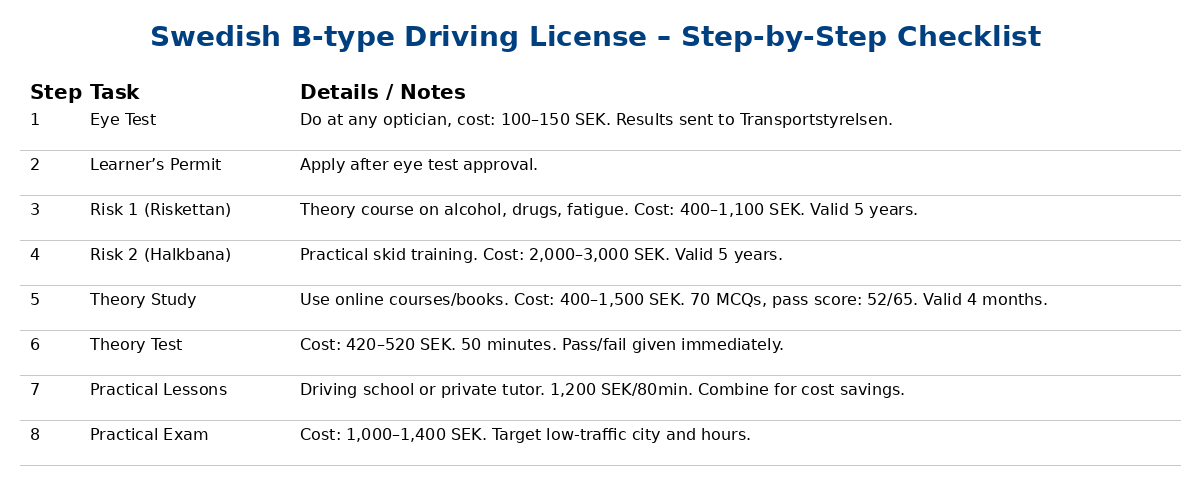Obtaining a driving license in Sweden is quite a challenging process — both mentally and financially.
The country has clearly defined standards and checkpoints that you must meet to pass. It is mentally demanding because instructors and examiners may fail you for even a small deviation from those standards. For example, when turning right, if you check the rear-view mirror and right mirror but forget to check your right-side blind spot, you will fail.
Financial Reality
For many Swedes, the process is easier financially. They often get support from their parents, who can act as instructors and provide a car for practice. Before taking the real exam, they may have 100–500 hours of driving practice. Statistically, it is said that you need at least 200 hours of driving to develop strong muscle memory.
For newcomers like me, it’s even more frustrating. We may not know the Swedish language or culture, and even if we already have a license from another country, our driving style may be seen as aggressive here. In many cases, we must relearn driving entirely according to Swedish standards.
If you rely fully on driving schools, money becomes a major factor. One lesson costs around 1,200 SEK for 80 minutes (at the time of this writing). To reach 200 hours through a school, you’d need around 150 lessons — costing about 180,000 SEK.
In practice, if you have prior driving experience, you might need a minimum 30–40 lessons (around 48,000 SEK). For complete beginners 40-100 lessons, costs can easily reach 100,000 SEK. If you plan to rely entirely on a driving school, save this money beforehand based on your situation. Pausing midway and resuming later often means retaking many lessons.
Time Commitment
Time is another key factor. You’ll need to dedicate time for studying, dealing with frustration, and even walking around to learn local roads and traffic conditions. If you’re already stressed, pursuing a license will feel much harder.
Ideally, set aside 2–4 months to focus on your driving license as a top priority during that period.
Seasonal tip: Plan your entire activity so that your practical exam falls around July or August. For example:
- March: Begin the process and apply for your learner’s permit.
- April: Finish reading the theory book.
- April–May: Focus on theory studies.
- May–July: Practical driving lessons.
- July–August: Take your practical exam.
This plan gives you long daylight hours for practice, which is much easier than learning in winter darkness.
Sweden’s Road Safety Approach
Sweden aims to minimize accidents and fatalities through strict standards and defensive driving principles. Drivers are expected to anticipate potential hazards and act appropriately in any situation. A driving license may offer freedom, but it comes with serious responsibility.
Understanding the standard checkpoints before your exam is critical. I highly recommend reading this free online theory book to get a solid grasp of what Transportstyrelsen expects from drivers. I even recommend it to city cyclists and predistrans.
Steps to Get a Driving License in Sweden (B-Type)
All the following information applies to a B-type driving license.
1. Eye Test
Make sure your vision meets the requirements. Visit any optician and request an eye exam for a driving license. The optician will send the results directly to Transportstyrelsen. This usually costs 100–150 SEK.
2. Learner’s Permit
Once your eye test is approved, you can apply for a learner’s permit.
3. Risk Training
Risk 1 (Riskettan) A theoretical course covering alcohol, drugs, fatigue, and other risky behaviors that impair driving. Cost: 400–1,100 SEK.
Risk 2 (Halkbana) A practical course that teaches handling dangerous situations, especially skidding on slippery roads — common in Nordic winters. Cost: 2,000–3,000 SEK.
Both Risk 1 and Risk 2 are valid for five years. You can search for authorised instructors offering risk courses here.
4. Theory Study
Covers traffic rules, signs, safety, vehicle knowledge, and eco-driving.
- Course cost: 400–1,500 SEK (depending on provider).
- 70 multiple-choice questions (5 are trial questions and don’t count).
- Passing score: 52 correct answers.
- Duration: 50 minutes.
- Theory test cost: 420–520 SEK.
- Pass is valid for four months.
There are many online theory practice tools — choose one that suits you. You can study through a driving school, but it’s not mandatory.
Tip: Alternate theory study with practical lessons to reinforce learning.
5. Practical Lessons
You can train at a driving school, with a private instructor, or both. Private practice requires an introductory course with your supervising driver at an approved school.
Since lessons are expensive, book them when you are calm and focused. Have at least a one-hour buffer before and after each lesson to avoid stress.
Stick to one instructor if possible. Changing schools often disrupts progress and costs more in the long run.
6. Practical Exam
- Cost: 1,000–1,400 SEK.
- Best time slots: 09:30 –11:00 or 13:30 –15:30 for lighter traffic.
- Aim for summer months when roads are quieter and weather is favorable.
- It matters where you practice and where you book your exam. Target the practical exam center first, then focus your practice in that city. This way, you’ll become familiar with local roads, traffic patterns, and common challenges in that area. Generally, the quieter the city, the higher your chances of passing the exam on the first try.
Cheaper Alternatives
- If you’ve been a Swedish resident for less than a year and have a valid non-EEA license, you can drive for one year. During this time, buy a cheap car, practice, study theory, take some lessons, and then book your test.
- Some people swap licenses in another country first (e.g., Denmark) and then exchange them for a Swedish license — if their original license is swappable there.
Foreign Driving Licenses in Sweden
- Non-EEA licenses: Valid for 1 year after becoming a Swedish resident. After that, you must pass the Swedish tests.
- EEA licenses: Valid until expiry. You can also swap them for a Swedish license.
Summing up

The two most important factors are time and money. Set aside the full budget so you don’t have to stop midway, and dedicate 3–5 months of focused effort. The rest is discipline, patience, and persistence.
If you think I’ve missed something or have experiences of your own to share, feel free to leave a comment below. Your insight might help others who are on the same journey.
